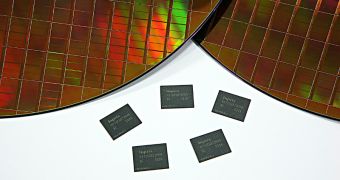After a time of experiencing decreasing prices, it seems that NAND Flash memory chips have broken out of the decline trend that DRAM is still subject to in order to start seeing their ASPs rise.
It appears that all the recent events that occurred on the NAND Flash market, like Toshiba's power outage, have changed the direction of NAND prices.
While before they were decreasing gradually, the same as DRAM, they rebounded not long ago, especially during December.
For those interested in numbers, prices are said to have rebounded by 5-11% during early December, at least as far as 32 Gb chips go.
Granted, the so-called sources that Digitimes cited in the report said that Toshiba's power outage didn't prove to be a very big contribution to this occurrence.
This assumption is based on the fact that, since December 8, when said outage took place, prices only grew by 3-5%.
The real factor behind the decision of chip suppliers to raise contract quotes is that smartphones and tablet PCs have been enjoying good demand.
Since such devices rely more or less exclusively on NAND, especially MLC (multi-level cell) chips, whether as memory cards or SSDs, such results are to be expected.
Basically, quotes are set to keep going up not just for the remainder of the month and, thus, the year, but also during the first quarter of 2011.
However, while January and February will yield price improvements, the rebound is not expected to be as good as the one during the past two weeks.
Digitimes also mentions in its report that downstream device makers have been reaping the benefits of these developments as well, although demand in the retail channel is still a bit slow.
This, in turn, led to what can be seen as a general impediment to such companies' desire to raise prices faster, though end-users will probably be glad of this.

 14 DAY TRIAL //
14 DAY TRIAL //